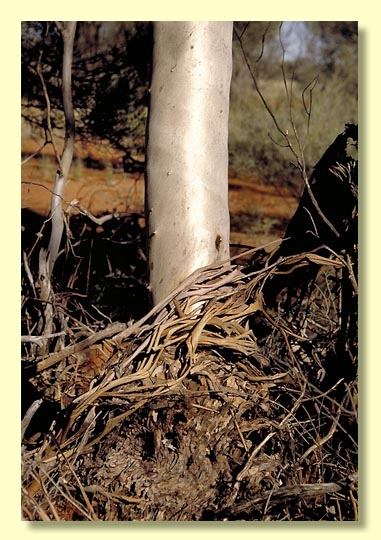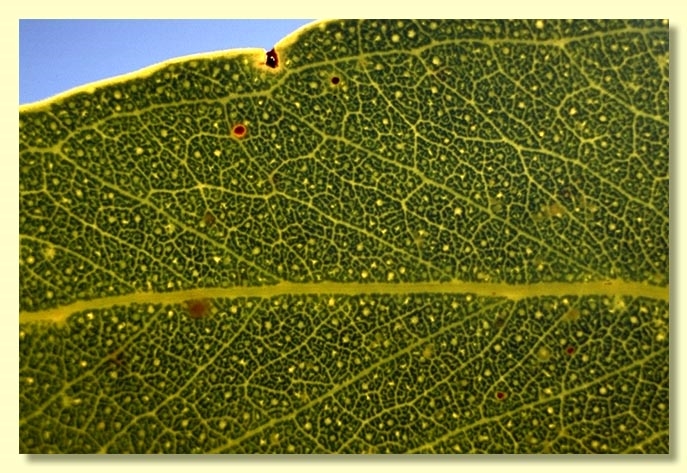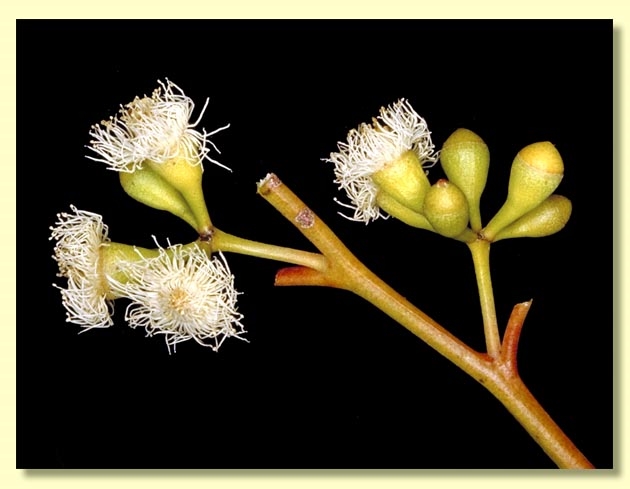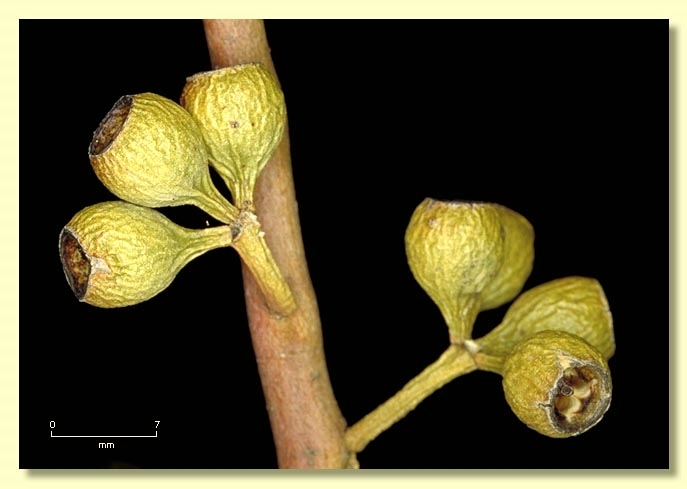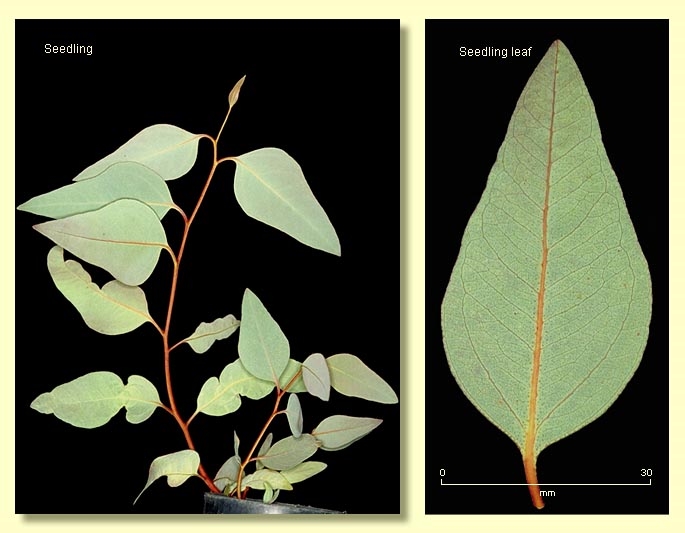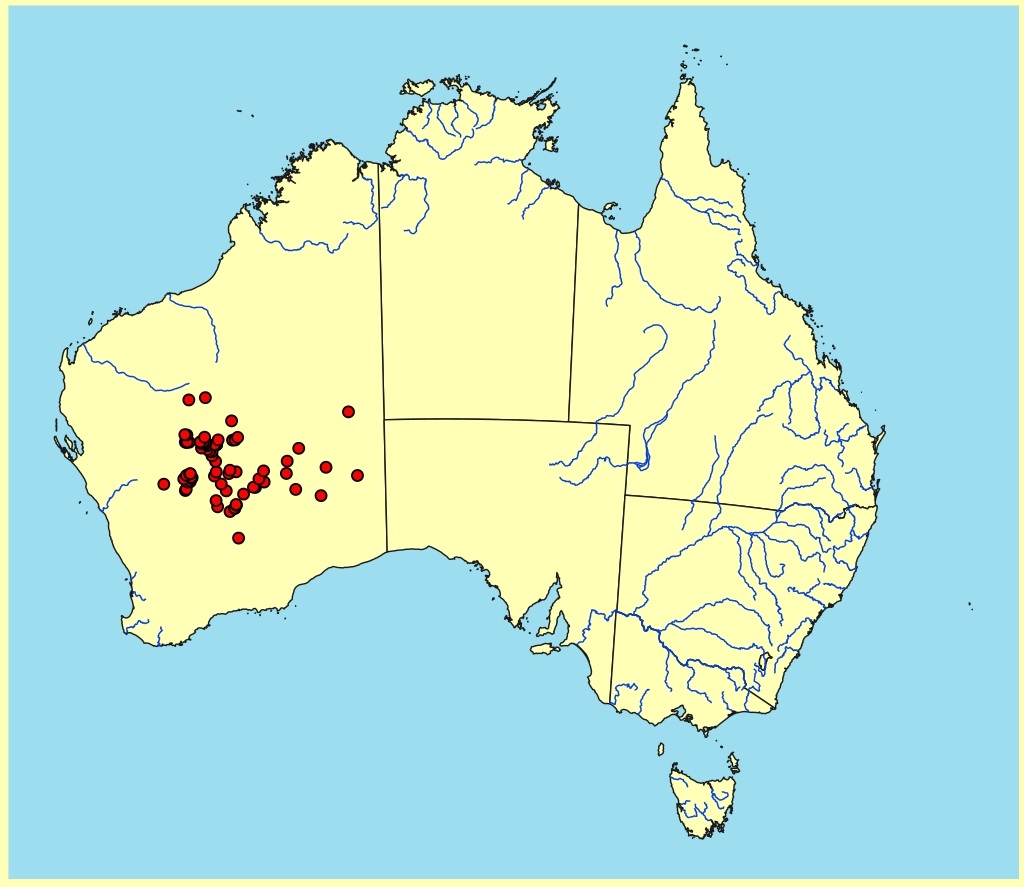Euclid - Online edition
Eucalyptus lucasii
Eucalyptus | Symphyomyrtus | Adnataria | Apicales | Buxeales | Amissae
Mallee to 10 m tall. Forming a lignotuber.
Bark smooth throughout or rough only at base of trunk, flaky or ribbony and persistent, grey-brown, smooth bark dark to pale grey and pinkish brown to white.
Branchlets lacking oil glands in the pith.
Juvenile growth (coppice or field seedlings to 50 cm): stems rounded or squared in cross-section; juvenile leaves always petiolate, alternate, lowest broadly elliptical soon ovate then broadly lanceolate, (6.5)8.5–14.5 cm long, 3.5–5.5 cm wide, dull grey to grey-green, usually not glaucous.
Adult leaves alternate, petioles 1–3 cm long; blade lanceolate, (7)8–15 cm long, 1–3 cm wide, base tapering to petiole, margin entire, apex pointed, concolorous, dull, light green to grey-green, side-veins at an acute or wider angle to midrib, reticulation dense, intramarginal vein remote, oil glands scattered, intersectional.
Inflorescence terminal compound, compound but with some single umbels in upper leaf axils also, peduncles 0.3–1.8 cm long, buds 7, 9 and 11 per umbel, pedicels 0.1–0.8 cm long. Mature buds obovoid, 0.3–0.6 cm long, 0.2–0.4 cm wide, scar present (outer operculum lost early), operculum broadly conical to rounded, stamens inflexed, the outer filaments without anthers (staminodes), inner filaments fertile, anthers more or less cuboid, adnate, sub-dorsifixed, dehiscing by sub-terminal pores, style long and straight, stigma blunt or slightly widened, locules 4 or 5, the placentae each with 4 vertical rows of ovules. Flowers creamy white.
Fruit pedicellate or sessile (pedicels 0.1–0.8 cm long), cupular to cylindrical or obconical, 0.5–0.8(1) cm long, 0.4–0.6 cm wide, disc descending, valves 4 or 5, enclosed or just below rim level.
Seeds brown, 1–2.2 mm long, ovoid to flattened-ovoid, dorsal surface shallowly reticulate, hilum ventral.
Cultivated seedlings (measured at node 10): cotyledons reniform; stems square in cross-section; leaves always petiolate, opposite for ca 4 or 5 nodes, then alternate, ovate to broadly lanceolate, 5–9 cm long, 2–4 cm wide, dull, grey-green.
Flowering has been recorded in all months from April to November.
A mallee or stunted tree endemic to Western Australia, of the northern goldfields from the Leonora district and western part of the Great Victoria Desert in the south, extending north to the Little Sandy Desert. It occurs on arid plains and floodouts with often hard red soil. The bark is smooth, or on larger plants rough for half of the stem, adult leaves are dull, grey-green or light green, fruit cupular to barrel-shaped on slender pedicels.
In the classification of Brooker (2000) Eucalyptus lucasii belongs in Eucalyptus subgenus Symphyomyrtus section Adnataria (the boxes) because the buds have two opercula, ovules are in four rows, seeds are flattened-ovoid, cotyledons are reniform, and anthers are rigid on the staminal filaments. Within section Adnataria, E. lucasii is part of a subgroup, series Buxeales, further distinguished by being partially rough-barked, having terminal inflorescences and buds that lose the outer operculum early. Most species in series Buxeales are found in south-eastern Australia, with only six occurring in Western Australia, viz. E. cuprea, E. absita, E. normantonensis, E. lucasii, E. aridimontana and E. rowleyi. All six species have inflexed stamens the outermost of which lack anthers(staminodes), features separating them to some extent from the eastern species. Both E. absita and E. cuprea occur further south in better watered areas. E. normantonensis is found north and east of the distribution of E. lucasii, and has more extensive rough bark, chocolate brown smooth bark and smaller buds and fruit. E. lucasii differs from both E. absita and E. cuprea in having dull, not glossy, adult leaves, less rough bark or none at all and in being distributed in more arid regions.
Eucalyptus lucasii has been studied by Nicolle & French (2012) and segregated into three species viz.: E. lucasii fully formed adult leaves always dull, fruit with slender angular pedicels the angles not extending to body of fruit; E. aridimontana fully formed adult leaves always glossy, green, fruit barrel-shaped with two angles extending from base down thickened pedicel; E. rowleyi also ultimately has glossy broad adult leaves and more or less cylindrical to barrel-shaped or weakly urn-shaped fruit on thickened angular pedicels the angles extending to the fruit. E. lucasii and E. rowleyi both occur on similar low hard country whilst E. aridimontana is restricted to mountaintops and ridges on areas of haematite at altitudes greater than ca 900 m.
Eucalyptus lucasii may be confused with the superficially similar widespread arid zone tree, E. intertexta, but that species has all stamens perfectly formed in the flowers.


